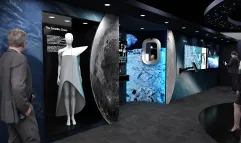Welcome to this last instalment of our Euclid story with the satellite about to soar skyward atop a Falcon 9 rocket on its mission to probe the depths of the cosmos!
Last time, we left the team at Cape Canaveral as they prepped the satellite for its imminent launch. Now, Euclid is ready to bid farewell to planet Earth.
Before the final countdown, we chatted with Paolo Musi, program manager for the Euclid satellite, who reflects on this extraordinary decade-long team endeavor.
© Thales Alenia Space
In his words, effective teamwork between everyone involved has been the key to getting this super-advanced ESA satellite off the ground. The Euclid program is a collaboration between the European Space Agency and the national space agencies of Italy, France and various other nations, working with industry partners, all driven by a shared passion for space science.
The industry partners who’ve contributed their expertise to this masterpiece of European technology include:
- Leonardo, responsible for the fine guidance sensor, solar cell assembly and cold gas micropropulsion.
- Altec, which helped develop and will jointly operate the science datacenter in Italy.
- Airbus, in charge of the payload module.
Euclid has been fueled with hydrazine and nitrogen gas, and the ground protectors are being removed. The satellite will then be installed inside the SpaceX Falcon 9 payload fairing for final tests before the rocket is rolled out to the launch pad, marking its last day on Earth.

© ESA
One-of-a-kind mission to fathom the cosmos’s deepest secrets
During its six-year mission, Euclid will study dark matter and energy in the depths of the cosmos and capture the faintest signals from billions of galaxies to help unlock some of the Universe’s longest-held mysteries. It will map the formation of large-scale cosmic structures out to a distance of more than 10 billion light-years and show how the Universe has expanded and evolved over a full three-quarters of its existence since the Big Bang. This will answer some of the most fundamentally important questions in cosmology today — how was the Universe formed and why is it expanding at an ever faster rate, rather than being slowed by gravitational attraction?
From everyone at Thales Alenia Space, we wish fair winds and following seas to our beloved Euclid!


